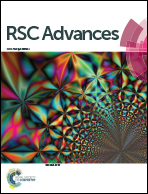Template-free hydrothermal synthesis of amphibious fluorescent carbon nanorice towards anti-counterfeiting applications and unleashing its nonlinear optical properties†
Abstract
Anisotropic fluorescent carbon nanostructures, namely carbon nanorice (CNR), has been prepared hydrothermally, without using any template, from a commercially available beef extract (BE) bio-precursor at a temperature of 150 °C. The structural and morphological characterizations of the synthesized sample have been carried out using transmission electron microscopy (TEM) and Raman spectroscopy. It has been proposed that the synthesized CNR structures have been formed due to the coalescence of initially formed small spherical carbon nanocrystals during hydrothermal treatment. The third order nonlinear refractive index (n2) of the synthesized CNR has been measured using the spatial self-phase modulation (SSPM) technique, for the first time, and a high optical nonlinearity with an n2 value of the order of 10−6 cm2 W−1 was obtained. The origin of such high nonlinearity is the reorientation of the sp2 graphitic core of CNR in response to intense laser radiation coupled with the thermal lensing effect. A theoretical simulation has been carried out to explain the formation of experimental optical diffraction ring patterns, which have occured due to SSPM of a continuous wave He–Ne laser beam of 632.8 nm wavelength. Furthermore, the synthesized CNR structures have been found to exhibit excitation-dependent tunable photoluminescence (PL) emission with visible blue light emission in liquid dispersion as well as in a PVA matrix, under 365 nm UV light irradiation. This amphibious nature in PL emission characteristics of the synthesised CNR structures has also been utilized in successful demonstration of using CNR structures as an anti-counterfeiting agent and indicates their potential future applications in photonic devices.



 Please wait while we load your content...
Please wait while we load your content...